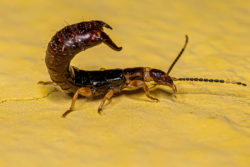Earwigs are not common household pests; in fact, they are sometimes referred to as “occasional invaders.” These pests have elongated, flat bodies that are reddish brown to black in color. They have pincers on the front of their bodies that they use as both a defense mechanism and to catch prey. Earwigs are commonly found in groups and favor moist, shady habitats. They feed on plants and flowers. They don’t spread diseases and aren’t harmful to humans.
There are several things that might attract earwigs to your home:
- Moisture/Humidity: Moisture can accumulate around your house through clogged or blocked gutters, leaky faucets, bushes and shrubs that block the sun from reaching the soil to help evaporate moisture, and even compacted soil or heavy thatch. Earwigs will also be drawn to basements and crawlspaces as these areas are known to hold moisture and humidity, as well. Keep gutters clear and free of debris. Trim back shrubs and bushes. Aerate your lawn to remove thatch and loosen soil. Consider crawlspace enclosure or the use of a dehumidifier in crawlspaces and basements.
- Wood Rot: Wood rot is caused by moisture, as mentioned above. Rotted wood not only attracts earwigs but other pests like termites, as well. Earwigs are known to live or hide in wood holes and rotted wood provides them with the ideal place to inhabit. Keep moisture away from wood in your home and repair or replace rotted wood immediately.
- Yard Debris: Earwigs prefer moisture and shade and debris in your yard provides exactly that. Piles of raked leaves are the perfect place to hide and reproduce. They will also seek out wood piles, piles of sticks or tree limbs, building materials, and more. Keep your yard free of debris and store wood away from the home.
- Landscaping: Earwigs feed on plants, flowers, and the tiny insects that also eat them. They are attracted to your yard for the food source and will then come indoors when weather conditions deteriorate outdoors.
If you have a problem with earwigs or any other pests, call McCall for a thorough inspection, treatment, and prevention plan.



